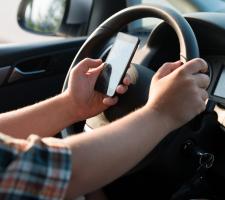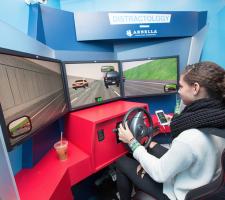
Many countries have laws prohibiting texting while driving but enforcement is proving difficult – David Crawford looks at some new approaches being tried by authorities.
Finding definitive solutions – technological, regulatory and educational - to the potentially lethal practice of people driving while using mobile phones is proving elusive, while the stakes grow higher. Most alarming of the recent manifestations of human stupidity are crashes by drivers playing the location-based Pokémon Go game while at the wheel.
US figures show that, at any given daylight moment across the country, some 660,000 drivers are using mobile phones or other electronic devices while on the road, a number that has held steady since 2010. The Virginia Tech Transportation Institute has found a 23 times higher crash risk when drivers text while driving.
Bans on texting while driving are widespread throughout the world but the problem is how to enforce those laws. In the US, where 46 States now outlaw the practice, police are having to resort to some very low-tech, if ingenious, solutions.
In Tennessee, they patrol in a tractive unit, giving officers the advantage of height in detecting offenders. In Maryland, an officer disguised as a homeless man stood beside a busy junction and radioed alerts ahead to colleagues further down the road. In Massachusetts, a bike-borne officer pedals up to drivers at traffic lights and hands offenders tickets.
According to Deborah Hersman, president and chief executive of the US National Safety Council: “Law enforcement can ask people, ‘Can I see your phone?’, but they can refuse.” The US Federal Communications Commission says that it’s “seeking to identify and facilitate the development of innovative technologies that could reduce the incidence of distracted driving.” There have already been a number of initiatives.
A 2013 field test of employer-distributed, app-based filter/blocker systems, carried out by the University of Michigan Transportation Research Centre for the US Department of Transportation’s National Highway Traffic Safety Administration (NHTSA) involved 44 volunteers from the Michigan State Department of Transportation. All drove as part of their jobs.
Asked later if they felt that they had gained any safety benefits, most thought that their participation would not have any lasting effect and strongly opposed systematic installation. Issues that arose included increased battery drain, the costs of employer monitoring and maintenance as well as lost levels of productivity from personnel meant to be on call.
More recently, Canadian company Synq Technology has developed QDrive, an app-based interlock system. This requires drivers to open the app before they can start their car, and in doing so it locks out their phone screen and removes their ability to text or speak on the phone while moving.
An override can allow the driver to send a short message, in a case of emergency - but the system records the event for later analysis. For practical reasons a valet mode enables another driver to move the vehicle a short distance, within a set range of up to 1km.
A commercial version is on the way for trucking company and fleet operators as well as car sharing and rental companies. The system can monitor usage during driving, using the phone’s built-in mechanisms for tracking speed and location. One claimed benefit is to enable motorists to prove to their insurers (or, in the case of young drivers, parents) that they were physically unable to use their smartphone while on the road.
Virginia-based ComSonics has made some progress in researching the feasibility of a type of ‘radar gun’, that would allow police use to detect whether passing cars are emitting text message radio frequencies. Technically, the approach is said to be similar to that used by cable repair teams looking for ‘leaking’ frequencies.
The company has, however, shelved the project for the time being due to the pace of evolution of mobile phone technology within the scope of the Long-Term Evolution (LTE) standard for high-speed wireless communications. It has also identified the need for the cooperation of mobile comms network providers.
These tend to favour an ‘all-or-none’ solution – in other words, they are waiting for governments to take a step beyond simply banning texting towards enforcing it via general legislation, which they will hope to be able to influence and will then have to obey. A spokesperson for the GSMA, which represents, globally, some 800 mobile operators and 300 suppliers of hardware, software and services, told ITS International: “This is not an issue that we have so far been asked to work on by our members.”
But one major actor, Apple, has had a patent registered for a highly developed lock-out system that would automatically detect and block the use of text messaging or other smartphone functions when an iPhone-using driver is at the wheel. The patent describes three core elements.
The first is a motion analyser, configured to detect whether a vehicle is in motion beyond a predetermined threshold. The second is a ‘scenery’ analyser, designed to determine whether the device is located within a safe operating area, based on photographic and/or video data.
The third is the lock-out mechanism, which reacts to outputs from the other two components. There has been speculation that the mechanism could integrate with the company’s CarPlay technology.
In New York State, officials are showing interest in a ‘textalyser’ device being developed by Israeli company Cellebrite, which has created a specialisation in mobile forensics aimed at law enforcement and military clients. A police officer arriving at the scene of a crash would plug in the mobile phones of drivers involved to detect the presence of any texting activity at the time of the incident. Built-in safeguards would avoid owners having to unlock their phones while also preventing access to the actual content of any messages.
New York State senators have put forward proposals for trials, with a view to adoption. Also interested are police in the Australian State of Victoria, where the country’s new metadata retention laws, allowing the tracking of phone calls, texts and emails for the benefit of law enforcement agencies, could speed the introduction of the technology.
Educating drivers
Short of legislation, a number of practical driver educational initiatives are under way in the US. The Massachusetts-based Arbella Insurance Foundation, for example, has supported the development of an 11m-long ‘Distractology’ mobile classroom which houses a pair of driving simulators.These offer training programmes based on research carried out by the Human Performance Laboratory at the University of Massachusetts Amherst. The targets are new (mainly young) drivers who, the Foundation claims, are far less likely to be involved in accidents after completing a course.
Back in September 2013, New York State Governor Andrew M Cuomo unveiled an initial series of 91 ‘texting zones’, to encourage drivers to pull off to use their mobiles. These are located at existing rest stops, park-and-rides and other parking areas, and supported by directional signage.
At a national level, the NHTSA has recently updated its web-based communications resource for state and highway safety professionals, offering them campaign and marketing materials for deterring texting while driving and other hazardous behaviours. It makes the point that, by using its materials, any one region ‘can make an impact that will reach beyond your community’. The website also hosts an ideas exchange.
Industry attitudes
To gauge the European auto industry’s feelings about the issue, independent motoring charity the
The results have shown that the issue of in-vehicle driver distraction is not a priority area for most respondents. A mobile phone manufacturer did not see it as being his industry’s responsibility to restrict user behaviour.
Since in-vehicle electronics can in principle allow the disabling of some forms of connectivity, many respondents thought that the automatic blocking of mobile phones while on the road would ultimately be the most effective solution. But the technology is “either not available or problematic.” One telecoms provider thought it would be the least effective in today’s conditions because “poor automotive ICT integration goes back years.”
- ABOUT THE AUTHOR: David Crawford has spent 20 years writing about and researching ITS and is a Contributing Editor to ITS International.














